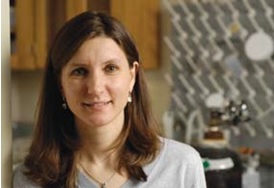
Technology now allows researchers to manipulate matter on the scale of a nanometer—one 5,000th the width of a human hair. From tiny electronic circuits to little gears and pumps, scientists are developing all sorts of nano-scale devices that could be useful in everything from computers to medical devices.
But the physical world at that scale often exhibits unexpected properties that can be troublesome to the device designer. Among these effects are the often counterintuitive interactions of surfaces, which can stick together when you would expect them to slide past each other, or vice versa.
Joelle Frechette, an assistant professor of chemical and biomolecular engineering, is exploring these interfacial interactions, with an eye toward helping designers not just to work around them but actually to take advantage of them.
“In many cases, surfaces or interfaces are considered a problem. When any device gets small enough, interfacial and surface forces become important. My view is not to look at this as a problem but as forces that can be harnessed,” Frechette says.
Earlier this year, Frechette received a National Science Foundation Faculty Early Career Development (CAREER) award of $400,000 for a proposal to develop ways to achieve external, reversible, and local control of wetting and adhesion properties.
At the nanoscale, for instance, tiny “capillary bridges” of water or other liquids can form between surfaces, and they can interfere with the electronic or mechanical functioning of the devices. Frechette wants to figure out how these bridges can be controlled and even made useful. So she is studying exactly how they can be modified through changes to the wettability of the surfaces they form on and through the application of electric fields. What happens when the wettability of surfaces—how much they attract or repel liquids-—is changed? She also wants to examine electrowetting, a technique in which an electric charge can be used to influence the shape and movement of nanodroplets.
The work can have implication for the fairly new field of optofluidics, which combines optics and microfluidics. Breakthroughs in optofluidics could lead to better low-power display technology for computers or cell phones. They might also produce better designs for “labs-on-a-chip,” a micro-scale tool, which could manipulate liquids in tiny, discrete quantities.
To study the interactions she’s interested in, Frechette uses a piece of equipment called a surface force apparatus (SFA). The SFA uses two moving plates to measure separation to a resolution of 0.1 nanometer, and surface forces to 10 nanonewtons.
Frechette has been studying surface forces ever since earning her PhD in chemical engineering and materials science at Princeton University in 2005. From there she went on to a postdoctoral fellowship at University of California, Berkeley, before joining Hopkins Engineering in 2006.
“Our group is tackling important issues in surface or interfacial science, keeping in mind that the results one day could be used in new generations of devices,” Frechette says.




